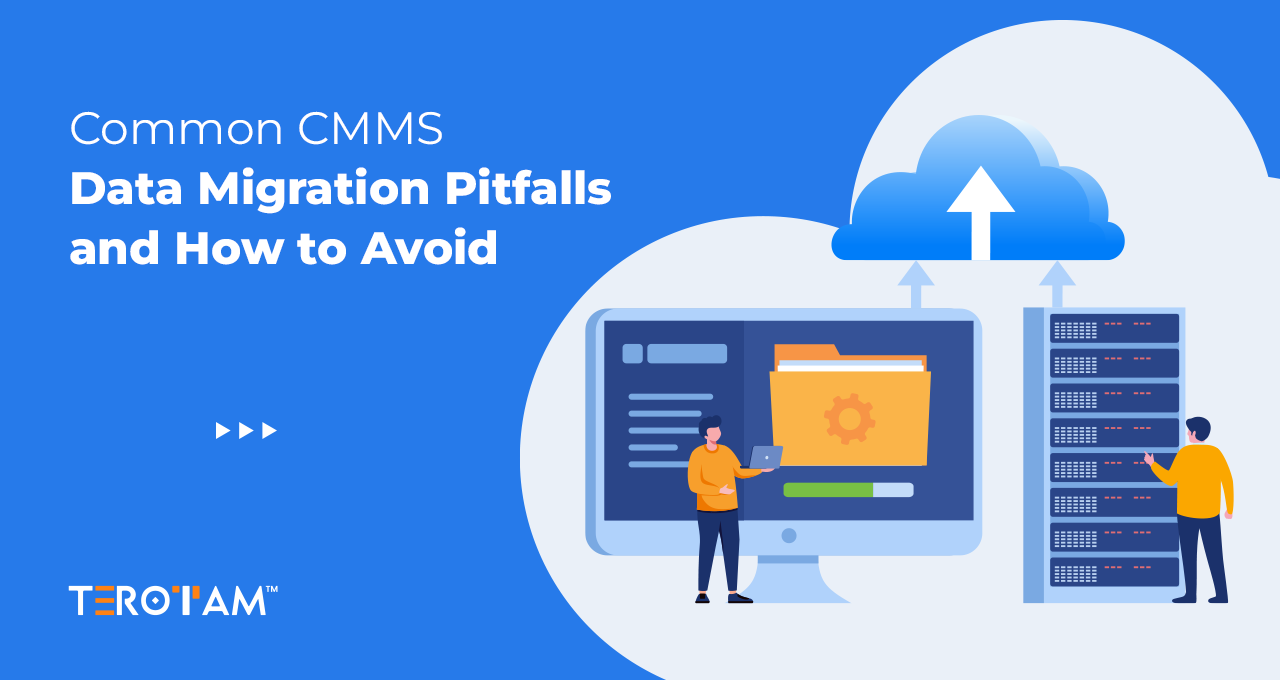A maintenance team can only move as fast as its information. When technicians waste time hunting for asset details, checking serial numbers, or confirming which pump is which in a crowded plant, work slows down and errors creep in. That’s where a CMMS with QR code and barcode scanning completely changes how you track, manage, and maintain your assets across sites.
Instead of chasing spreadsheets, faded stickers, or memory, every asset gets a scannable identity that links straight to its full digital profile in your CMMS. The result is faster work, fewer mistakes, better decisions, and a maintenance operation that finally “sees” what is happening on the ground in real time.
In this article, we’ll look at how QR code and barcode features inside a CMMS simplify asset tracking, which technical capabilities actually matter, how this helps maintenance teams every day, and how a solution like TeroTAM puts it all together.
Why traditional asset tracking breaks down in maintenance operations
Maintenance teams usually start with simple tools: Excel asset registers, shared folders with manuals, maybe some basic tags on machines. This works for a small site with a few assets and a stable team. As the plant grows, sites multiply, and team members change, traditional methods start to fail and asset information becomes scattered and outdated.
When that happens, technicians spend more time confirming which asset they are working on than actually fixing issues. Work orders end up logged against the wrong asset, warranty claims fail due to incorrect serial numbers, and inventory movements never get recorded accurately. These problems show up every single day in busy facilities.
Key problems with manual or basic asset tracking:
- Asset identity confusion on site
Two motors on the same line look similar, have similar power ratings, and even sit next to each other. Without clear, scannable IDs linked to the CMMS, technicians can easily pick the wrong one when logging work or raising a fault. - Serial numbers and nameplates are hard to read
Dust, oil, rust, and poor lighting make printed nameplates hard to read. Technicians often guess or skip detailed entry because it slows them down, which leads to bad data in the system. - Disconnected asset registers and work orders
When the asset list is in one file and work orders are managed somewhere else, linking history to the correct asset becomes a manual step. That extra step rarely happens during busy shifts, so history gets fragmented or lost. - Poor traceability across locations
Assets are moved between plants, stores, or outlets. If this movement isn’t captured, teams lose track of where items actually are. Transfer records in emails or WhatsApp chats never make it back to a central system. - Audit and compliance headaches
During audits, you need proof of maintenance history, inspection logs, and current status for specific assets. Without a clear, unique and easily accessible ID for each asset, audit preparation becomes a stressful, time-consuming exercise.
What QR codes and barcodes bring to CMMS-based asset tracking
QR codes and barcodes convert every asset into a scannable data point that the CMMS can understand instantly. Each code represents a unique identifier. When a technician scans it with a mobile app, the CMMS pulls up that asset’s full profile, work history, and open jobs in seconds.
This turns asset tracking from a manual data entry activity into a simple scan-and-work process. The CMMS handles the linkage between the asset ID, work orders, spare parts, and locations in the database. Maintenance teams then focus on the job itself instead of typing codes or searching lists.
Some important aspects of QR/barcode usage in CMMS:
- Unique asset IDs linked to rich profiles
Every QR or barcode is tied to a unique asset record inside the CMMS. That record can hold specifications, manuals, images, warranty details, maintenance schedules, failure history, and vendor info. Scanning instantly opens this full context. - Support for multiple code formats
A capable CMMS supports common linear barcodes (such as Code 128) and 2D codes (such as QR). That allows flexibility in label design, density of information, and compatibility with existing label standards in your industry. - Label strategies for harsh environments
Industrial labels may need to survive chemicals, heat, moisture, and rough handling. A good setup considers label material, size, placement, and cleaning practices so that codes remain scannable over the asset’s life. - Mobile-first workflows
QR and barcode scanning only make sense when your CMMS provides a robust mobile app. Technicians must be able to scan, view details, log work, and close tasks directly from phones or tablets on the shop floor or at remote sites.
How a CMMS with QR and barcode scanning simplifies asset tracking
Once QR and barcode scanning are embedded in your CMMS, asset tracking becomes a single continuous process. Every movement, inspection, repair, and check-in happens against a unique asset ID with minimal manual typing.
1. Faster and accurate asset identification on site
Technicians no longer need to read tiny plates, remember naming conventions, or scroll through long asset lists. They simply scan the code on the asset and land on the exact record in the CMMS.
- A scan immediately confirms which asset they are standing in front of, reducing miscommunication between operations and maintenance.
- The system auto-fills asset IDs and descriptions in work orders, so human error is drastically reduced.
- New technicians can start working effectively much earlier, as they don’t have to memorise asset layouts or naming patterns.
2. Automated link between work orders and asset history
Every time a technician scans an asset to log a fault, start a preventive task, or record a reading, the CMMS records that activity under the same asset ID. Over time, you build a clean, accurate maintenance history without extra effort.
- Fault reports, preventive work, condition monitoring readings, and inspections all stack under a unified asset record.
- Reliability analysis, MTBF/MTTR calculations, and failure pattern studies become much more trustworthy because the data isn’t mixed up between similar assets.
- Warranty tracking improves because you can always show exactly what work was done on a specific serial-numbered asset.
3. Real-time location and movement tracking
In multi-site organisations, assets move between stores, outlets, plants, or even temporary sites. QR and barcode scanning make those movements visible in the CMMS.
- When an asset is installed at a new location, the installer scans the code and updates the location in a few taps.
- During pull-outs or transfers, staff can scan items during dispatch and receipt, ensuring the CMMS reflects where each asset actually lives.
- Logistics, finance, and maintenance teams see the same live information, which reduces lost assets and disputes.
4. Cleaner inventory and spare parts control
The same scanning approach extends to spare parts and consumables. Each part or bin location can have its own QR or barcode, linked to stock levels and reorder rules in the CMMS.
- Technicians scan parts while issuing them for a job, and stock levels adjust automatically in the system.
- Cycle counts become faster and more accurate because staff scan shelves instead of writing long codes.
- Reorder suggestions are based on real usage rather than guesswork, which supports better cost control.
5. Easier audits, compliance, and asset verification
When assets and their histories are tightly connected through scannable codes, audits become much smoother.
- Auditors can pick random samples, scan the asset on site, and instantly see its maintenance history, calibration records, and inspection certificates.
- Verification cycles such as annual physical asset counts become straightforward – teams scan assets and reconcile counts against the CMMS list.
- Compliance records for safety-critical equipment remain ready and traceable on demand.
Key technical capabilities to look for in a CMMS with QR and barcode scanning
Not every CMMS handles scanning in the same way. Maintenance and IT teams should evaluate both functional and technical aspects to ensure the tool actually fits their operations.
Important capabilities include:
- Robust mobile app with offline support
Technicians should be able to scan codes and work even in low network areas (basements, plant rooms, remote locations). The app must sync automatically when connectivity returns. - Configurable asset and code structures
Different organisations prefer different asset coding schemes. Your CMMS should allow custom fields, code patterns, and hierarchies (plant → line → machine → component) without forcing a rigid model. - Label printing and re-tagging workflows
The system should help you generate codes and print labels for new assets, re-tag damaged labels, and track which IDs are active or retired. - Security and role-based access
Some asset data is sensitive (cost, vendor discounts, warranty terms). Role-based access control ensures field teams see what they need without exposing everything. - Integration with existing systems
If you already use ERP or fixed asset accounting software, the CMMS should integrate IDs and relevant fields so you don’t create duplicate asset universes. - Support for different hardware
Teams may use smartphones, rugged tablets, or dedicated scanners. The CMMS should support camera-based scanning as well as hardware scanners through standard protocols.
How TeroTAM CMMS uses QR and barcode scanning for smarter asset tracking
TeroTAM is designed for organisations that manage distributed assets across multiple sites such as retail chains, manufacturing units, healthcare facilities, education campuses, and service networks. QR and barcode scanning is built into the platform, with specific workflows for field teams and managers.
Here’s how TeroTAM brings this feature to life:
- Centralized asset register with scannable IDs
Every asset in TeroTAM can be tagged with a QR or barcode and linked to a complete profile: technical specs, documentation, images, warranty details, and preventive schedules. A simple scan on the mobile app pulls this up instantly. - Scan-to-create and scan-to-work features
Technicians can raise fault tickets, start work orders, log inspections, and record readings by scanning the asset code. This reduces typing, speeds up reporting, and keeps asset-level data clean and consistent. - QR-based location and site management
TeroTAM supports use cases where sites, rooms, or sections themselves have QR codes. Staff scan a site code and then assets within that site, helping maintain clear mapping between locations and equipment. - Integrated inventory and spare parts tracking
Spares and consumables can also be managed with QR/barcode scanning so that issues, returns, and stock adjustments flow directly into inventory records in TeroTAM. Managers get better visibility of what is consumed where and when. - Reporting and analytics with reliable asset data
Since every scanned activity lands on the correct asset record, TeroTAM’s reports on downtime, failure patterns, warranty usage, and preventive compliance reflect the real situation on the floor. Decision-makers can rely on these insights to plan budgets and upgrades.
Implementation roadmap: moving to QR and barcode-enabled asset tracking
Switching from manual or semi-digital asset tracking to a CMMS-driven, scan-based model doesn’t have to be disruptive. A structured rollout approach makes adoption smoother for teams.
Practical steps to implement:
- Audit and clean your existing asset list
Start with consolidating all existing asset data into one master list. Remove duplicates, standardise naming, and ensure each asset has a clear location and category. - Define an asset coding and labelling strategy
Decide how you will group and code assets (by plant, line, function, criticality). Set rules for where labels will be placed and which label types will be used in harsh areas. - Choose the right CMMS and mobile setup
Select a CMMS such as TeroTAM that supports QR/barcode scanning, offline work, configurable fields, and easy label management. Test mobile performance with your actual site conditions. - Pilot with a subset of assets and one team
Pick one plant, one building, or one region to run a pilot. Tag assets, train technicians, and track the impact on work order accuracy, response times, and asset visibility. - Train teams on scanning-first behavior
Encourage a simple rule: “No job starts without scanning the asset.” This one habit ensures that all activity ties back to the correct record. - Scale gradually and refine standards
After the pilot, refine label placement rules, data fields, and workflows. Then roll out step by step across more plants and asset groups.

Conclusion
A CMMS with QR code and barcode scanning shifts asset tracking from guesswork and manual effort to a structured, scan-based system that maintenance teams actually enjoy using. Technicians save time, data quality improves, and managers gain a clear view of where assets are, how they perform, and what they cost to maintain over time.
When you combine robust scanning features with a capable CMMS platform such as TeroTAM, asset tracking becomes a natural part of daily work rather than an extra admin burden. That sets the foundation for better reliability, safer operations, and smarter maintenance decisions.
If you want to explore how TeroTAM can support QR and barcode-enabled asset tracking for your organization, drop us a line to contact@terotam.com







